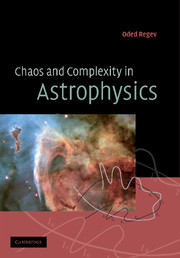Book contents
- Frontmatter
- Contents
- Preface
- Acknowledgements
- Part I Dynamical systems – general
- 1 Introduction to Part I
- 2 Astrophysical examples
- 3 Mathematical properties of dynamical systems
- 4 Properties of chaotic dynamics
- 5 Analysis of time series
- 6 Regular and irregular motion in Hamiltonian systems
- 7 Extended systems – instabilities and patterns
- Part II Astrophysical applications
- References
- Index
3 - Mathematical properties of dynamical systems
Published online by Cambridge University Press: 14 January 2010
- Frontmatter
- Contents
- Preface
- Acknowledgements
- Part I Dynamical systems – general
- 1 Introduction to Part I
- 2 Astrophysical examples
- 3 Mathematical properties of dynamical systems
- 4 Properties of chaotic dynamics
- 5 Analysis of time series
- 6 Regular and irregular motion in Hamiltonian systems
- 7 Extended systems – instabilities and patterns
- Part II Astrophysical applications
- References
- Index
Summary
Mathematics may be defined as the subject in which we never know what we are talking about, nor whether what we are saying is true.
Bertrand Russell, Mysticism and Logic.A dynamical system has already been loosely defined in Chapter 1 as a set of rules by the application of which the state of a physical (or other well defined) system can be found, if some initial state is known. The origin of this name is in Newtonian mechanics, where a system of particles is described by ODE in time. If the initial state is specified, the ODE can be solved (at least in principle) to give the particles' state at any other later time. It should be stressed that the above mentioned set of rules can define a meaningful dynamical system only if it implies a unique evolution. Dynamical systems are deterministic. This is obvious in mechanics, since a particle cannot be at two different positions at the same time.
Mathematically, a dynamical system is a set of equations – algebraic, differential, integral or combination thereof, the solution of which provides the above mentioned rule of evolution with time (or some other independent variable). The equations may contain given parameters and the study of the dependence of the systems' behaviour on these parameters is often very important and interesting.
The notion of a dynamical system is used nowadays almost always as a synonym for a nonlinear system, i.e., one containing nonlinear evolution equations. In this book we shall deal mainly with such nonlinear dynamical systems; linear behaviour, when encountered, will be an exception. An overwhelming majority of systems taught and studied in the exact sciences are linear.
- Type
- Chapter
- Information
- Chaos and Complexity in Astrophysics , pp. 40 - 111Publisher: Cambridge University PressPrint publication year: 2006



